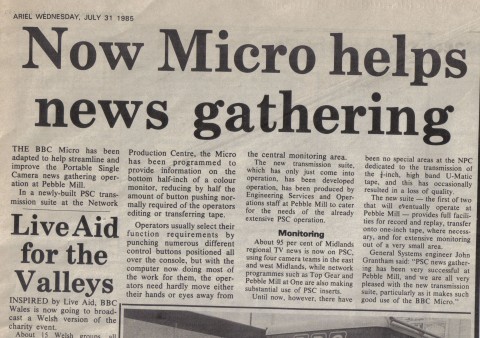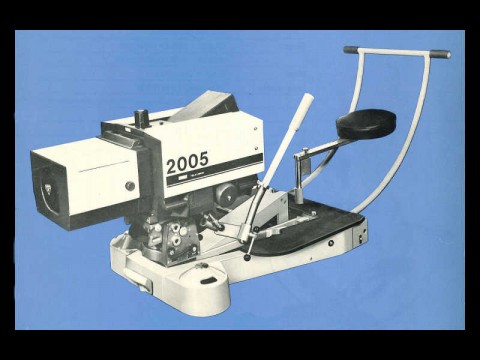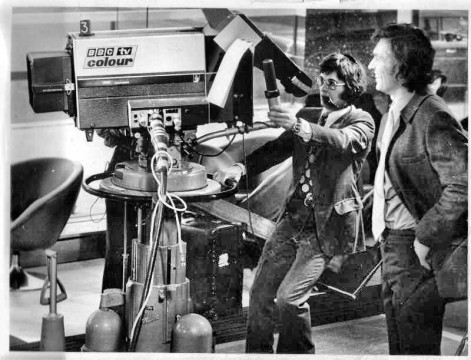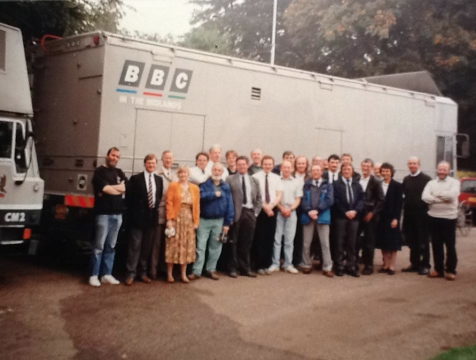
photo by Robin Sunderland no reproduction without permission
(Photo shows a rehearsal of ‘Pebble Mill at One’, Donny MacLeod interviewing Harry Carpenter, FM Nick Patten, cameraman Brian Cave)
Ah, the EMI 2001, what a wonderful camera.
First, a digression.
In the black & white days, cameras had a single tube called an ‘Image Orthicon’. Basically a bloody big vacuum tube, or ‘valve’, with a flat end onto which the image was shone. Inside the tube, a beam was fired at that image, in the same raster scan as your TV set, which was reflected back stronger or weaker depending on the brighter or darker parts of the image. These tubes were huge, 4½” in diameter (a few were 3″), and almost the full length of the camera.
Four lenses were positioned on a ‘turret’ which was ‘swung’ either by manually rotating a handle at the rear or, in one case, by flicking a switch to electrically drive them in either direction. Focussing was done by a lever which moved the tube backwards and forwards. Thus, the lenses stayed still and you moved the tube to focus.
Now, introduce colour and it’s a whole new can of worms. It would be almost impossible to move three large tubes, Red, Green and Blue, complete with prism block to split the colours, and keep the whole lot registered. CBS had a go and the BBC experimented too, but they were attacking the problem from the wrong direction.
Perhaps keep the tubes still and move the lenses? Equally impractical with a bunch of them on a turret.
Eventually, two elements conspired to make the late 60’s, early 70’s, colour camera a reality.
Firstly, the invention of the ‘Plumbicon’ tube which reduced the size to about 1″ in diameter and 6″ in length. This allowed a compact block and tube assembly.
Secondly, with a smaller image size on the tube front, reasonably sized zoom lenses became a practicality.
So far so good.
Unfortunately, cameras were designed by engineers who really didn’t consult cameramen. Thus, we were given a camera with a large body and a monster zoom lens, the same size again, nailed to the front.
This had a number of bad effects.
Firstly, to balance it, the whole weight would be shifted rearwards compared with a black & white camera. This made it very difficult to reach the steering ring on the Vinten peds. A larger ring was eventually fitted, but not before many cameramen had their backs ruined.
Secondly, the whole package, including the cameraman at the back and the minimum focussing distance at the front, was about 10ft. Not good, especially when crammed into the broom cupboards of Children’s TV in Pres A or ‘Old Grey Whistle Test’ in Pres B at Telly Centre.
Did I digress?
Oh yes, the EMI 2001.
Now, I’m not an engineer or a technician, but I’ve spent a lot of my career with my head buried inside these Emmys and we do have to know a little bit about them in order to help the engineers, especially on OBs where they can’t easily get to the camera. So, please forgive any ‘technical’ inaccuracies. I’m trying to explain the concept.
So, after you’ve chatted to cameramen, how do you make a camera that’s about the same size as a black & white one?
EMI’s approach was to find a lens that would fit inside a small-ish body and then figure out where to put the rest of the stuff.
Angenieux came up with a design that was compact enough to meet the size criterion including all the motors and electronics to drive the thing and throw in a 10:1 capability as well.
That still left the problem of the tubes and electronics to drive the camera. Fairly important.
The solution was very elegant.
Only have the tubes and prism inside the camera with the rest of the electronics at the other end of the cable, up in racks. Ok, you need some electronics but they were wrapped around the hole that the lens sat in.
Then, make a prism that allows the tubes to ‘fan out’ at almost 90deg to the light path from the lens. That way you can stuff them in the four corners of the box and only add about 6″ to the whole package.
Stick a few cameraman controls at the back and you’re good to go.
There’s another very clever element that EMI designed in. These tubes were horrifically expensive and to have three in each camera, four cameras in each studio, and so on, meant that the BBC bosses would have to have smaller bonuses.
There was a huge attrition rate in the manufacture of these smaller tubes with only a fraction passing the full broadcast test.
EMI’s engineers realised that the human eye is less sensitive to colour than to monochrome. That’s why, in the dark, really dark, we can’t see colours.
Their solution was to have four tubes. An expensive one that gave a full spec monochrome picture, and three much cheaper, lower quality, ones that were subtracted from the ‘white’ tube to give the colours. Brilliant!!
As it happens, that’s how the NTSC/PAL system works anyway, so it was an extremely elegant system.
So, you get a cameraman’s camera. You get great pictures for the time. And you get a device that enabled us to work on drama in a much more intimate way.
How that affected us is in Part 2.
Keith Brook (aka Scouse)
The following comments were left on the Pebble Mill Facebook Group:
Dave Bushell: ‘EMI 2001 – the tinted monochrome camera – never a fan (but I was an engineer, not a cameraman).’
Matthew Skill: ‘Surely they can’t be described as tinted monochrome, almost the reverse in fact; colour with added luminance detail, a-la the original technicolour 4-strip before they ditched the fourth film ( mirrored decades later in the 2005 only having 3 tubes ). I was a TA, then novice engineer, when we had them too in Newcastle. Remember the 2001s for the BBC allegedly had a different matrix fitted to lower the overall saturation, as either the powers that be were apparently worried about being as ‘gaudy’ as ITV, or BBC engineering wanted to keep chroma content at a ‘safe’ level for the subsequent chain. Beautiful pictures seen ‘raw’ at the Grade 1 connected component/RGB to the CCU, all we see now is composite quad/1″ recordings so the comparison with modern cams isn’t fare based purely on those.’
Andy Walters: ‘There was an EMI 2001 with it’s rack on display in the foyer of Breedon Wing at Wood Norton last time I was there. They had them at ATV Broad Street too back in the day.’
Keith Brook: ‘I think almost all stations had them. I was lining up an Emmy up on the gantry at Wembley stadium because one of the engineers was flashing the cue lights. After a while I asked his name because I didn’r recognise his voice. That’s when I realised I was lining up an LWT camera!! We didn’t mind so I carried on. They all looked the same from the back!!’




